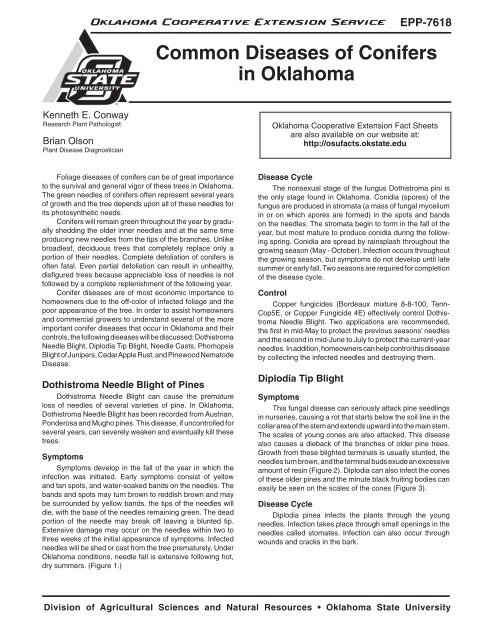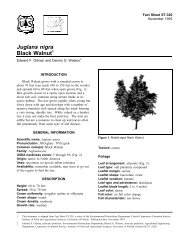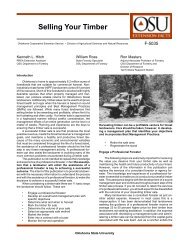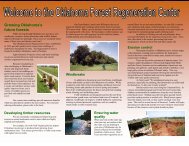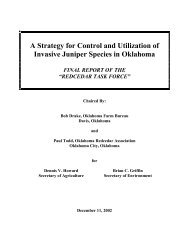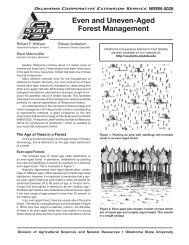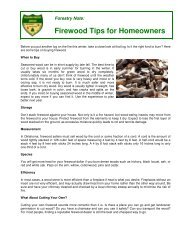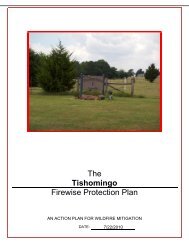Common Diseases of Conifers in Oklahoma - OSU Fact Sheets ...
Common Diseases of Conifers in Oklahoma - OSU Fact Sheets ...
Common Diseases of Conifers in Oklahoma - OSU Fact Sheets ...
Create successful ePaper yourself
Turn your PDF publications into a flip-book with our unique Google optimized e-Paper software.
<strong>Oklahoma</strong> Cooperative Extension ServiceEPP-7618<strong>Common</strong> <strong>Diseases</strong> <strong>of</strong> <strong>Conifers</strong><strong>in</strong> <strong>Oklahoma</strong>Kenneth E. ConwayResearch Plant PathologistBrian OlsonPlant Disease Diagnostician<strong>Oklahoma</strong> Cooperative Extension <strong>Fact</strong> <strong>Sheets</strong>are also available on our website at:http://osufacts.okstate.eduFoliage diseases <strong>of</strong> conifers can be <strong>of</strong> great importanceto the survival and general vigor <strong>of</strong> these trees <strong>in</strong> <strong>Oklahoma</strong>.The green needles <strong>of</strong> conifers <strong>of</strong>ten represent several years<strong>of</strong> growth and the tree depends upon all <strong>of</strong> these needles forits photosynthetic needs.<strong>Conifers</strong> will rema<strong>in</strong> green throughout the year by graduallyshedd<strong>in</strong>g the older <strong>in</strong>ner needles and at the same timeproduc<strong>in</strong>g new needles from the tips <strong>of</strong> the branches. Unlikebroadleaf, deciduous trees that completely replace only aportion <strong>of</strong> their needles. Complete defoliation <strong>of</strong> conifers is<strong>of</strong>ten fatal. Even partial defoliation can result <strong>in</strong> unhealthy,disfigured trees because appreciable loss <strong>of</strong> needles is notfollowed by a complete replenishment <strong>of</strong> the follow<strong>in</strong>g year.Conifer diseases are <strong>of</strong> most economic importance tohomeowners due to the <strong>of</strong>f-color <strong>of</strong> <strong>in</strong>fected foliage and thepoor appearance <strong>of</strong> the tree. In order to assist homeownersand commercial growers to understand several <strong>of</strong> the moreimportant conifer diseases that occur <strong>in</strong> <strong>Oklahoma</strong> and theircontrols, the follow<strong>in</strong>g diseases will be discussed: DothistromaNeedle Blight, Diplodia Tip Blight, Needle Casts, PhomopsisBlight <strong>of</strong> Junipers, Cedar Apple Rust, and P<strong>in</strong>ewood NematodeDisease.Dothistroma Needle Blight <strong>of</strong> P<strong>in</strong>esDothistroma Needle Blight can cause the prematureloss <strong>of</strong> needles <strong>of</strong> several varieties <strong>of</strong> p<strong>in</strong>e. In <strong>Oklahoma</strong>,Dothistroma Needle Blight has been recorded from Austrian,Ponderosa and Mugho p<strong>in</strong>es. This disease, if uncontrolled forseveral years, can severely weaken and eventually kill thesetrees.SymptomsSymptoms develop <strong>in</strong> the fall <strong>of</strong> the year <strong>in</strong> which the<strong>in</strong>fection was <strong>in</strong>itiated. Early symptoms consist <strong>of</strong> yellowand tan spots, and water-soaked bands on the needles. Thebands and spots may turn brown to reddish brown and maybe surrounded by yellow bands. the tips <strong>of</strong> the needles willdie, with the base <strong>of</strong> the needles rema<strong>in</strong><strong>in</strong>g green. The deadportion <strong>of</strong> the needle may break <strong>of</strong>f leav<strong>in</strong>g a blunted tip.Extensive damage may occur on the needles with<strong>in</strong> two tothree weeks <strong>of</strong> the <strong>in</strong>itial appearance <strong>of</strong> symptoms. Infectedneedles will be shed or cast from the tree prematurely. Under<strong>Oklahoma</strong> conditions, needle fall is extensive follow<strong>in</strong>g hot,dry summers. (Figure 1.)Disease CycleThe nonsexual stage <strong>of</strong> the fungus Dothistroma p<strong>in</strong>i isthe only stage found <strong>in</strong> <strong>Oklahoma</strong>. Conidia (spores) <strong>of</strong> thefungus are produced <strong>in</strong> stromata (a mass <strong>of</strong> fungal mycelium<strong>in</strong> or on which spores are formed) <strong>in</strong> the spots and bandson the needles. The stromata beg<strong>in</strong> to form <strong>in</strong> the fall <strong>of</strong> theyear, but most mature to produce conidia dur<strong>in</strong>g the follow<strong>in</strong>gspr<strong>in</strong>g. Conidia are spread by ra<strong>in</strong>splash throughout thegrow<strong>in</strong>g season (May - October). Infection occurs throughoutthe grow<strong>in</strong>g season, but symptoms do not develop until latesummer or early fall. Two seasons are required for completion<strong>of</strong> the disease cycle.ControlCopper fungicides (Bordeaux mixture 8-8-100, Tenn-Cop5E, or Copper Fungicide 4E) effectively control DothistromaNeedle Blight. Two applications are recommended,the first <strong>in</strong> mid-May to protect the previous seasons’ needlesand the second <strong>in</strong> mid-June to July to protect the current-yearneedles. In addition, homeowners can help control this diseaseby collect<strong>in</strong>g the <strong>in</strong>fected needles and destroy<strong>in</strong>g them.Diplodia Tip BlightSymptomsThis fungal disease can seriously attack p<strong>in</strong>e seedl<strong>in</strong>gs<strong>in</strong> nurseries, caus<strong>in</strong>g a rot that starts below the soil l<strong>in</strong>e <strong>in</strong> thecollar area <strong>of</strong> the stem and extends upward <strong>in</strong>to the ma<strong>in</strong> stem.The scales <strong>of</strong> young cones are also attacked. This diseasealso causes a dieback <strong>of</strong> the branches <strong>of</strong> older p<strong>in</strong>e trees.Growth from these blighted term<strong>in</strong>als is usually stunted, theneedles turn brown, and the term<strong>in</strong>al buds exude an excessiveamount <strong>of</strong> res<strong>in</strong> (Figure 2). Diplodia can also <strong>in</strong>fect the cones<strong>of</strong> these older p<strong>in</strong>es and the m<strong>in</strong>ute black fruit<strong>in</strong>g bodies caneasily be seen on the scales <strong>of</strong> the cones (Figure 3).Disease CycleDiplodia p<strong>in</strong>ea <strong>in</strong>fects the plants through the youngneedles. Infection takes place through small open<strong>in</strong>gs <strong>in</strong> theneedles called stomates. Infection can also occur throughwounds and cracks <strong>in</strong> the bark.Division <strong>of</strong> Agricultural Sciences and Natural Resources • <strong>Oklahoma</strong> State University
Figure 1. Dothistroma needle blight on Austrian p<strong>in</strong>e.ControlSeedl<strong>in</strong>gs and young trees that are <strong>in</strong>fected with the stemrot phase cannot be treated successfully. When Diplodia TipBlight has been a problem <strong>in</strong> seedl<strong>in</strong>g production, the use <strong>of</strong>steam-pasteurized soil or soil fumigants will help <strong>in</strong> controll<strong>in</strong>groot and stem <strong>in</strong>fection.Diplodia Tip Blight on older trees can be controlled byprun<strong>in</strong>g and sanitation. As soon as blighted term<strong>in</strong>als andcones are noticed, the needles, twigs and cones should bepruned to healthy tissue and destroyed. Do not prune whenthe branches are wet because the conidia <strong>of</strong> the fungus caneasily be spread when moisture is present. Where <strong>in</strong>fectionhas been severe, the use <strong>of</strong> Bordeaux mixture or CopperFungicide 4E will control this disease. It should be appliedearly <strong>in</strong> the spr<strong>in</strong>g, when the buds open, and twice more atweekly <strong>in</strong>tervals until the needles break through the needlesheaths. An application <strong>of</strong> fungicide <strong>in</strong> the fall may also aid<strong>in</strong> slow<strong>in</strong>g the spread <strong>of</strong> the disease; however, fertilizationand water<strong>in</strong>g <strong>in</strong> the fall may be more beneficial. Homeownerswho ma<strong>in</strong>ta<strong>in</strong> vigorous trees through good tree health carewill have fewer problems with Diplodia Tip Blight.Needle CastsSymptomsThe first <strong>in</strong>dication <strong>of</strong> this tree disease is the scorchedbrown or yellowish appearance <strong>of</strong> most <strong>of</strong> the needles. Manyp<strong>in</strong>es are affected by this disease and it can become a severeproblem <strong>in</strong> Christmas tree plant<strong>in</strong>gs. The <strong>in</strong>itial discoloration <strong>of</strong>the needles is followed by needle fall or cast<strong>in</strong>g. Few trees areactually killed by this defoliation but susta<strong>in</strong>ed needle kill willeventually reduce the overall growth rate and make the treemore susceptible to other diseases and <strong>in</strong>sect attack. Over40 different species <strong>of</strong> fungi are capable <strong>of</strong> caus<strong>in</strong>g needlecase. The more important ones are Lophodermium p<strong>in</strong>astri,Hypoderma lethale, and Hypoderma hedgcockii.Disease CycleSmall black elliptical fruit<strong>in</strong>g bodies <strong>of</strong> the fungus areproduced on the needles. These structures break open <strong>in</strong> thelate spr<strong>in</strong>g or early summer dur<strong>in</strong>g periods <strong>of</strong> wet weather andrelease great numbers <strong>of</strong> spores. The spores can be spreadby splash<strong>in</strong>g ra<strong>in</strong> or w<strong>in</strong>d to <strong>in</strong>fect other needles or trees.Figure 2. Stunted term<strong>in</strong>al branch <strong>of</strong> p<strong>in</strong>e <strong>in</strong>fected withDiplodia p<strong>in</strong>ea.Infected needles beg<strong>in</strong> to turn brown dur<strong>in</strong>g the late fall andearly spr<strong>in</strong>g and will have a mottled appearance due to thedeath <strong>of</strong> needle tissue at the <strong>in</strong>fection sites. Temperature andhumidity are very important <strong>in</strong> determ<strong>in</strong><strong>in</strong>g the severity <strong>of</strong> the<strong>in</strong>fection.ControlIn nurseries this disease can be controlled by the application<strong>of</strong> the fungicide after the needles are half grown followedby a second application when the needles are fully developed.No chemical control measures are normally recommendedfor homeowners even though the tree may appear unsightly.Collection <strong>of</strong> <strong>in</strong>fected needles and their destruction will greatlyreduce this disease. However, if a homeowner wishes tocontrol this disease, the proper application <strong>of</strong> a fungicide willprovide excellent control.Phomopsis Blight <strong>of</strong> JunipersThis is the most common disease <strong>of</strong> cedar, juniper, andarborvitae <strong>in</strong> <strong>Oklahoma</strong>. Phomopsis Blight can be a severeproblem <strong>in</strong> nursery plant<strong>in</strong>gs and can cause the death <strong>of</strong> manyseedl<strong>in</strong>gs. Older trees are less affected by Phomopsis Blightand unless these trees are environmentally stressed or <strong>in</strong>poor health they are usually not affected enough to warrantchemical sprays.Symptoms and Disease CycleInfected trees will exhibit brown<strong>in</strong>g <strong>of</strong> the foliage and dy<strong>in</strong>g<strong>of</strong> twigs and branches (Figure 4). Small black fruit<strong>in</strong>g bodies <strong>of</strong>the fungus, Phomopsis juniperovora, are formed on this deadtissue. Conidia are produced <strong>in</strong> these structures and whenmoisture is present masses <strong>of</strong> conidia will ooze out to formtendrils or horns. The conidia are spread by ra<strong>in</strong> and variousother means such as mechanical disruption and <strong>in</strong>sects. Thefungus enters the plant through wounds as well as unbrokentissue. The brown<strong>in</strong>g <strong>of</strong> the needles and twigs beg<strong>in</strong>s at thetips and progresses downward toward the stem. Moisture isan important factor <strong>in</strong> disease spread and severity. Nurseriesand Christmas tree plantations that utilize overhead irrigation7618-2


